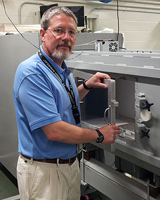Defense Medical Research and Development
Characterization of a Model of Blast-induced Mild Traumatic Brain Injury



Posted July 21, 2016
Joseph B. Long, Ph.D., Walter Reed Army Institute of Research

Blast has emerged as the prevalent cause of casualties in Operation Iraqi Freedom (OIF) and Operation Enduring Freedom (OEF), with the majority of these injuries resulting from blast propagated by improvised explosive devices (IEDs). Among these casualties, the large majority (98%) of neurotrauma patients have closed head (i.e., nonpenetrating) injuries that predominantly result in mild traumatic brain injury (mTBI). Many Warfighters who sustain blast-induced TBI in combat are exposed to a brain insult resulting from a combination of both a shock wave and biomechanical perturbation related to rapid acceleration and/or impact with a solid object. The TBI resulting from these combined insults is likely to be fundamentally different from that seen from either insult alone. In 2011, Dr. Long and his colleagues at the Walter Reed Army Institute of Research (WRAIR) were funded under the Psychological Health and Traumatic Brain Injury Broad Agency Announcement to define the pathophysiological mechanisms underlying blast-induced TBI, to devise improved means to mitigate the risk of brain injury after blast exposure, and to identify rational therapeutic interventions.
Dr. Long’s research team has identified that the putative mediator of chronic traumatic encephalopathy, phosphorylated tau protein (pTau), is significantly elevated in a time-dependent manner in different brain regions after blast exposure or weight drop injury. In addition, these investigators determined that the maximum phosphorylation of Tau proteins occurred at the early stages of injury and that the degree of Tau phosphorylation varied across different regions of the brain. Furthermore, the increase in pTau was in close association with decreased expression and activity of non-specific alkaline phosphatase. Non-specific alkaline phosphatase is the enzyme primarily responsible for dephosphorylating pTau and restoring microtubule assembly for regeneration. These findings point to a neurobiological link between acute brain injuries and this tau protein-linked neurodegenerative disorder.
Dr. Long and his colleagues have also found large and sustained blast-induced elevations of the neuroinflammatory mediator chemokine ligand 2 (CCL2), and its receptor, in brain and cerebral spinal fluid. The sustained high levels of CCL2 in the central nervous system after blast may have cytotoxic effects and contribute to neurodegeneration and/or chronic traumatic encephalopathy and therefore could be an important target for therapeutic intervention. These findings point to another likely neurobiological link between sustained neuroinflammatory processes triggered by acute brain injuries and the pathogenesis of chronic neurodegenerative disorders.
To summarize, Dr. Long’s results to date are consistent with the hypothesis that blast overpressure generates a closely associated insult to the brain that compromises the brain’s resilience in addition to exacerbating the pathophysiological effects of other injury modalities such as impact acceleration. Further development and validation of this animal model of blast-induced mTBI will provide a valuable experimental tool to assist ongoing efforts to mitigate the risks and consequences of blast-induced mTBI in Warfighters. Dr. Long also hopes that his rat model will help rationally establish effective countermeasures to lessen short-term impairments (e.g., return-to-duty) as well as chronic debilitation (e.g., chronic traumatic encephalopathy).
Links:
Last updated Thursday, December 5, 2024














